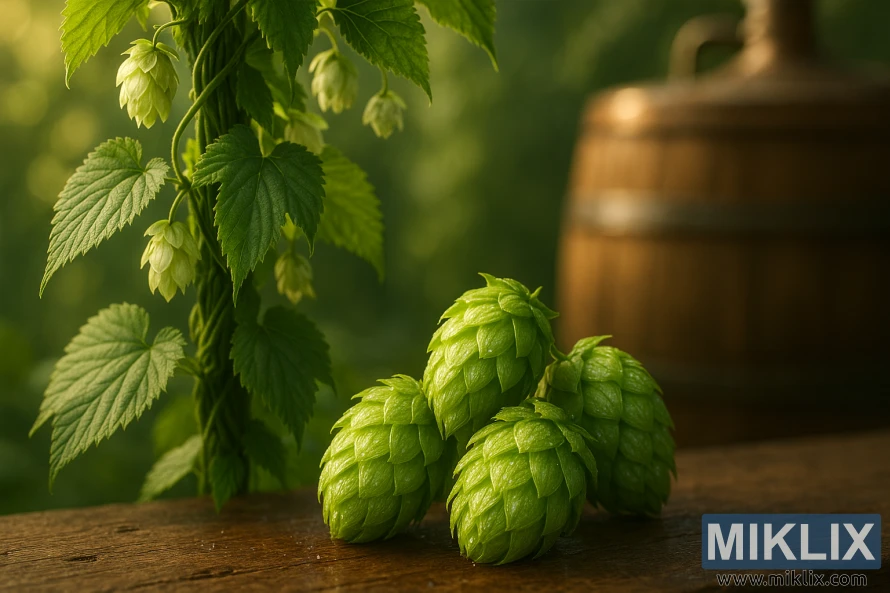Image: Agnus Hops and Brewing Tradition
Published: August 12, 2025 at 6:25:29 AM UTC
Last updated: September 26, 2025 at 8:22:48 PM UTC
Freshly picked Agnus hops cascade in golden light beside a wooden brewing vessel, symbolizing natural abundance and the harmony of agriculture and brewing.
In the soft golden light of a late afternoon, a rustic wooden surface supports a small but striking cluster of freshly harvested hop cones. Their vibrant green hue immediately catches the eye, each cone layered with overlapping bracts that create a delicate, scaled texture resembling miniature pinecones crafted from living leaves. These particular cones belong to the Agnus hop variety, a Czech-bred cultivar known for its balanced bitterness and subtle yet complex aroma profile. The cones in the image rest proudly in the foreground, their tightly packed lupulin-filled petals hinting at the resinous oils and acids within—substances that have made hops indispensable in brewing for centuries.
Behind the cones, a mature hop bine climbs upward, twisting elegantly as it reaches toward unseen trellises. The leaves are broad, deeply veined, and serrated at the edges, a deep green canvas that contrasts with the paler, almost luminous flowers dangling in small clusters. These blossoms, still attached to the climbing bine, serve as a reminder of the plant’s dual identity: both a graceful botanical marvel and a vital agricultural resource. The scene exudes freshness, as though the air is saturated with faint herbal and floral notes characteristic of newly harvested hops.
In the soft blur of the background, a traditional wooden brewing barrel looms. Its rounded form and dark staves evoke centuries of brewing heritage, tying together the agricultural and artisanal dimensions of beer production. The presence of the barrel suggests a story: the journey of these bright green cones, from field to kettle to cask. Agnus hops, though relatively modern compared to heritage Czech varieties like Saaz, are nonetheless steeped in brewing culture. Bred in the late 20th century at the Hop Research Institute in Žatec, Agnus represents a step forward in hop development—offering higher alpha acid content than traditional noble hops, while retaining a smooth bitterness and a character subtly reminiscent of its ancestral lines.
The atmosphere of the composition balances between nature’s tranquility and human craftsmanship. On one side, the hop bine embodies the seasonal cycle, dependent on sun, soil, and water, flourishing in the open air of hop-growing regions. On the other side, the brewing barrel symbolizes tradition, storage, and transformation—the process where these delicate green cones yield their oils and resins to shape the character of a finished beer. The juxtaposition creates harmony: the raw material and the vessel of its destiny standing side by side.
One can almost imagine the cones being picked and crushed gently in the hand, releasing their sticky lupulin glands with aromas of spice, herbs, faint citrus, and earthiness. For brewers, Agnus hops are valued not only for their bitterness but also for their balanced flavor contributions, which can range from subtle peppery spice to faintly fruity undertones depending on how they are used during the boil or as a late addition.
The lighting in the image intensifies this sense of vitality and warmth. Rays of sun filter through the leaves, highlighting the cones in the foreground with a natural glow, making them appear almost jewel-like. The composition conveys reverence, almost as if the hops are not merely agricultural products but treasures—symbols of centuries-old brewing traditions carried into the modern craft movement.
Every detail reinforces the narrative: the rustic table surface speaks of hands-on labor, the verdant plant of natural abundance, and the blurred barrel of cultural continuity. Together they create a scene that is not only visually pleasing but also steeped in meaning. It is a portrait of Agnus hops as more than a cultivar—they are a bridge between the fields of Central Europe, the artistry of brewers, and the shared human experience of gathering around a glass of beer flavored by the humble yet extraordinary cone of the hop plant.
The image is related to: Hops in Beer Brewing: Agnus

